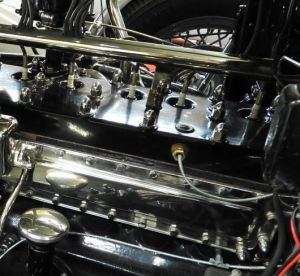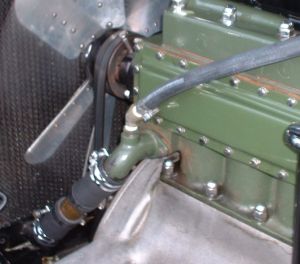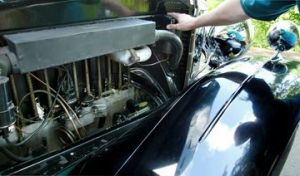- Home
- About Us
- Join/Renew
- Member Benefits
- Member Pages
- Log In
- Help
- Museum Store
My Car does not have a heater, and I may want to have one eventually. I see old heaters offered which would be restorable and of the appropriate vintage. There are two openings in the firewall steel on the passenger-side, about 1 inch in diameter and 10-12 inches apart in the vertical plane. There are no corresponding holes in the firewall pad, but it seems these might have been intended to ease installation of a heater by the dealer. There would need to be coolant connections at the engine so where would they be?
I’ve been a little puzzled over this matter.
I am shopping for a Pierce at the moment. My first, actually.
I’ve been looking at 5 cars from the 30’s. Two Twelves, two Eights. Four of them closed cars — Sedans.
Not a one has a heater. I don’t expect the open car to have, but Sedans?
I am somewhat astounded that being the highest quality cars of the era, and in the early to mid 1930’s, it was not standard for cars to have heater. And I’m sure that not all of these cars were sold in southern California.
Did no owner back in the day place value on comfort when driving or being driven?
Were people just so tough back then that even those who appreciated fine motoring didn’t give a second thought to heat?
Were these cars simply put up on blocks for the duration of winter?
Or was the technology just not there as late as 1935?
My Packard did not have a heater but I added one — an Arvin — and that makes ALL the difference in driving in the cooler season. Even California has chilly days, don’t they?
— Luke
I remember reading a long discussion of the heater topic, wish I could remember where. I believe the basic thought was that people would dress warmly, and a quality car like the Pierce was “insulated” well enough that some engine heat would come through the firewall and make it tolerable inside the car.
I think the “technology” was there, as far as hot water heaters supplied by the engine coolant, it just wasn’t a common option on most cars. I realize that you’re talking further North, but I remember up into the 1960’s that a lot of cars sold in my home state had no heaters…Louisiana….of course freezing temps were very rare there.
I apologize for hijacking Randy’s question on heater placement in his Model 43.
To wit, I cannot speak for the holes in the firewall but their location is about where you’d expect a hot-water heater like my Arvin to be mounted. My Packard had these holes although from the discussion it may have been unlikely that the factory placed them there. I don’t know.
The cylinder head might have a screw or some port blocked off near the water temperature sensor. I’ve been photos of Pierces with such port, as shown here. Again, my Packard had the same thing. Were these added at the factory? Apparently not but somewhere along the line, they were. But why would they be added if a heater was not installed? And why would a heater be removed once installed. Unless it was leaking. I’d appreciate anyone who would shed some light on this, especially what that blocked port really is in the top of the head above the water temperature sensor if it is NOT for a heater.
So, if I am right, one heater hose connects there. The other should go on the water inlet casting — where the water enters the cylinder block. Again, my Packard had a casting with another blocked off port just for this purpose.
Alternatively I’ve seen guys tap into the rubber radiator hoses as they exit the engine and as they enter the engine. Does not look good, in my opinion.

Other end of the heater hose connection, as described above.

Getting back to Peter’s comments on early heaters,
In addition to the exhaust gas heaters he describes, Model A Fords, Franklins and several other makes had exhaust manifold heater. They were some sort of enclosure around the exhaust manifold to warm air passing over. Then the warmed air was ducted into the passenger compartment.
The advantage over what Peter describes is there was no exhaust gas being piped into the passengers. The disadvantage was these heaters probably were not terribly effective.
The air intake on Model A’s and some others was just from the breeze blown in from the radiator fan, so air pressure wasn’t much. I’ve seen some better cars with an electric fan in a housing to provide air for this style heater.
Franklins being air cooled, used a pressurized blower with air ducted off the blower housing to assure a blast into the passenger compartment. This is shown in the photo. I hear they worked well.
And then there was the Southwind gasoline heater. Used into the 1960’s especially on VW’s, they drew gasoline from the carburetor, piped it into the firewall mounted heater (which looked similar to the Arvin heater in my upper photo) and lit off a fire inside the passenger compartment. They worked astoundingly well and provided instant heat — no waiting for the engine to warm up. And I think they were safe, in spite of some misgivings. They are available today either used or restored and ready to mount.

The first coolant systems with a small radiator type core were used by GM in the early 30’s.
The ’37 Nash had the first “sophisticated” heating system, with controls and baffles and such.
I remember driving my ’34 Pierce sedan in 45 degree weather (that’s frigid in Louisiana, where I was at the time!) and once the engine warmed up, the interior of the car was comfortable, and got heat through the firewall.
Cadillac offered a factory hot water heater in 1930 made by Harrison. They also offered an exhaust heater that year also. Proper plumbing of a heater is to place a fitting on the high pressure side of the water pump, run coolant through the heater, and then return somewhere on the low pressure side. They should also have a shut off valve for the summer. Gasoline heaters made by south wind were popular from 1927, and they work great, in 1984 I bought a NOS gas south wind in the box at Hershey and used it in a CJ7…….the only CJ7 in the world that was comfortable with a soft top in the winter.
My 1933 1236 EDL appears to have a factory installed exhaust heater system with adjustable vents in both the driver and passenger compartment. In the place of the manual throttle control on the dash, there is a switch for an electric fan. With the fan blowing, it really throws a lot of heat. Kind of strange, as the car was delivered new, and lived most of its life in Arizona.
My Series 80 has a port with a sliding door in the firewall, suggesting it once had a exhaust manifold heater such as a “Franciscoâ€. I have encountered the usual mix of vintage heaters at swap meets: Hershey, et al and when I find the right one I eill het started. As stated, I may never need a heater.
Even as late as the 1060’s, many car’s base price was with no heater. I remember a new car in our family, with the window sticker showing the heater as an additional cost item. I asked my Dad who would buy a car without at heater? We have always lived in Michigan, and a heater is NOT an option. More of a life and death necessity.
Of course, a high end car in the ’60’s would have heater/defroster and most likely A/C as standard equipment.
Greg Long
What’s preserving Greg so well is probably what he was drinking when he wrote “1060’s””.
— Luke”
My ’35 Pierce has a gasoline fired Southwind heater. It was in Wisconsin until I bought it. It was dealer installed and was a bit of a crude butcher job cutting a rectangular piece through the firewall for the gas, exhaust and electrical. The Southwind is in poor condition, but doesn’t really matter since it is too scary to think about installing a gasoline fired heater inside the car!
Not as crude as my ’36 Packard, which had a dealer installed hot water heater. The holes they cut in the firewall took out a corner of the serial plate. That heater was a generic without any brand. I later found a dealer unit with a Packard label on it.
Packard had provisions for plumbing a hot water heater coming out the top of the cylinder head and back to the temp regulator. Pierce did not. In anticipation of installing a hot water heater in my P-A, I cut down a brass pipe fitting that replaces some of the radiator upper hose, and soldered a smaller tube into it for a hot water takeoff. I also soldered a return tube into the large brass lower fitting between the radiator and water pump.
For years I ran the Packard hot water knee scorcher, it was very effective and with the thermosylphon shutter system it would warm up the car faster than any of my later cars. Then I added an under dash evaporative “swamp” cooler and was cooking my dear wife on hot days. The reason was I hadn’t installed insulation between the dash board and firewall, the pockets in the sides of the footwells, or most importantly, the floors above the exhaust pipe and mufflers.
After rectifying that and getting it much better insulated, it no longer was as comfy warm on cold days, but we don’t cook in the summer.
Jim
I own a Southwind heater. They were made by Stewart-Warner and millions were sold. They worked great and there was no risk from the operation of the unit. It took gasoline from the float bowl of the carb, and the products of combustion were taken into the intake manifold. They are commonly sold on Ebay and at swap meets, but almost never with the gasoline supply tube, and it will not work without it. It is much more than just a tube.
Just
Imagine the value of almost instant heat rather than waiting for the engine coolant to get to temperature, in a cold winter.
I looked more closely at my ‘31 today. I am convinced it had an accessory hot water heater at one time.
There is a Southwind heater on eBay right now.
Looks to be in great shape but without knowing more about them I can’t tell if it is missing critical pieces.
I spent a lot of money to buy one of those “Cadillac” heaters
mentioned above. Then I spent more to have it restored. In the meantime
I realized that my open 1932 Cad had enough heat pouring in from the
engine, even after heat and sound proofing. I have driven the car across
the US, on a trip to Canada and in six European countries….. and I
am very happy that I never installed that heater. Maybe air conditioning
would be nice, but NO heater. So drive your car some distances before you
decide that you need a heater.
Johnny
My ’29 Club Brougham appears to have a factory installed water source heater made by Tropic Aire. It has a Pierce style on-off switch with a Tropic Aire switch for the fan control. Pictures to follow, I hope…
Second Picture of factory style switch next to the spark advance.
Location of the inlet and outlet for the water on the firewall. This was not connected when I got the car, and did not have a way to connect it to the engine. The engine had a cracked block, so I am also looking for suggestions as to how to connect the heater to the coolant system.
Try again with the picture this time…
